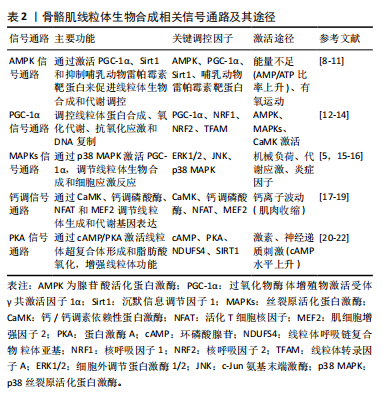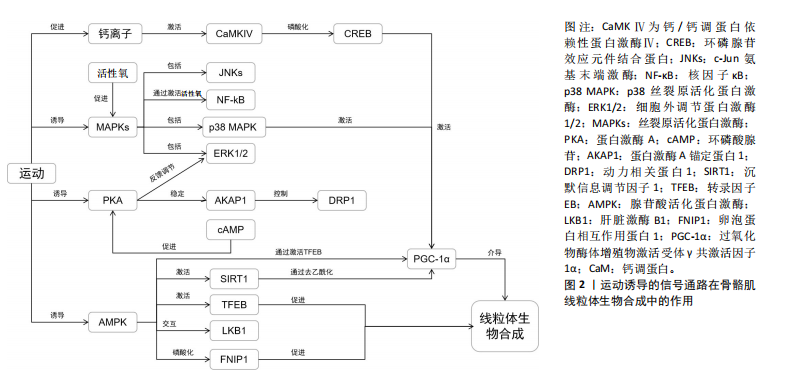[1] JUN L, KNIGHT E, BRODERICK TL, et al. Moderate-Intensity Exercise Enhances Mitochondrial Biogenesis Markers in the Skeletal Muscle of a Mouse Model Affected by Diet-Induced Obesity. Nutrients. 2024; 16(12):1836.
[2] PERIASAMY M, HERRERA JL, REIS FCG. Skeletal Muscle Thermogenesis and Its Role in Whole Body Energy Metabolism. Diabetes Metab J. 2017;41(5):327-336.
[3] VARGAS-ORTIZ K, PÉREZ-VÁZQUEZ V, MACíAS-CERVANTES MH. Exercise and Sirtuins: A Way to Mitochondrial Health in Skeletal Muscle. Int J Mol Sci. 2019;20(11):2717.
[4] GROENNEBAEK T, VISSING K. Impact of Resistance Training on Skeletal Muscle Mitochondrial Biogenesis, Content, and Function. Front Physiol. 2017;8:713.
[5] SOARES MENEZES E, WU Z, RENWICK JRM, et al. PERM1-An Emerging Transcriptional Regulator of Mitochondrial Biogenesis: A Systematic Review. Genes (Basel). 2024;15(10):1305.
[6] PELLEGRINO A, TIIDUS PM, VANDENBOOM R. Mechanisms of Estrogen Influence on Skeletal Muscle: Mass, Regeneration, and Mitochondrial Function. Sports Med. 2022;52(12):2853-2869.
[7] CRAIG DM, ASHCROFT SP, BELEW MY, et al. Utilizing small nutrient compounds as enhancers of exercise-induced mitochondrial biogenesis. Front Physiol. 2015;6:296.
[8] AUDET-WALSH É, VERNIER M, VIOLLET B. Editorial: AMPK and mTOR Beyond Signaling: Emerging Roles in Transcriptional Regulation. Front Cell Dev Biol. 2020;8:641552.
[9] LEE WJ, KIM M, PARK HS, et al. AMPK activation increases fatty acid oxidation in skeletal muscle by activating PPARalpha and PGC-1. Biochem Biophys Res Commun. 2006;340(1):291-295.
[10] LONG YC, ZIERATH JR. AMP-activated protein kinase signaling in metabolic regulation. J Clin Invest. 2006;116(7):1776-1783.
[11] XIAO L, LIU J, SUN Z, et al. AMPK-dependent and -independent coordination of mitochondrial function and muscle fiber type by FNIP1. PLoS Genet. 2021;17(3):e1009488.
[12] ABU SHELBAYEH O, ARROUM T, MORRIS S, et al. PGC-1α Is a Master Regulator of Mitochondrial Lifecycle and ROS Stress Response. Antioxidants (Basel). 2023;12(5):1075.
[13] CHEN L, QIN Y, LIU B, et al. PGC-1α-Mediated Mitochondrial Quality Control: Molecular Mechanisms and Implications for Heart Failure. Front Cell Dev Biol. 2022;10:871357.
[14] HALLING JF, PILEGAARD H. PGC-1α-mediated regulation of mitochondrial function and physiological implications. Appl Physiol Nutr Metab. 2020;45(9):927-936.
[15] MOENS U, KOSTENKO S, SVEINBJØRNSSON B. The Role of Mitogen-Activated Protein Kinase-Activated Protein Kinases (MAPKAPKs) in Inflammation. Genes (Basel). 2013;4(2):101-133.
[16] SHI J, JIANG Q, DING X, et al. The ER stress-mediated mitochondrial apoptotic pathway and MAPKs modulate tachypacing-induced apoptosis in HL-1 atrial myocytes. PLoS One. 2015;10(2):e0117567.
[17] CHIN ER. The role of calcium and calcium/calmodulin-dependent kinases in skeletal muscle plasticity and mitochondrial biogenesis. Proc Nutr Soc. 2004;63(2):279-286.
[18] GEHLERT S, BLOCH W, SUHR F. Ca2+-dependent regulations and signaling in skeletal muscle: from electro-mechanical coupling to adaptation. Int J Mol Sci. 2015;16(1):1066-1095.
[19] 钱帅伟,孙易,漆正堂,等.运动对线粒体稳态调控机制的研究述评:基于运动介导TFEB调节线粒体质量控制的关键机制探讨[J].体育科学,2020,40(2):70-82.
[20] LEFKIMMIATIS K, LERONNI D, HOFER AM. The inner and outer compartments of mitochondria are sites of distinct cAMP/PKA signaling dynamics. J Cell Biol. 2013;202(3):453-462.
[21] SIGNORILE A, PACELLI C, PALESE LL, et al. cAMP/PKA Signaling Modulates Mitochondrial Supercomplex Organization. Int J Mol Sci. 2022;23(17):9655.
[22] YANG H, YANG L. Targeting cAMP/PKA pathway for glycemic control and type 2 diabetes therapy. J Mol Endocrinol. 2016;57(2):R93-R108.
[23] 靳丹,代新宇,刘淼,等.肌肉骨骼减少症发病机制及其运动防治效果[J]. 生物化学与生物物理进展,2024,51(5):1105-1118.
[24] CORK GK, THOMPSON J, SLAWSON C. Real Talk: The Inter-play Between the mTOR, AMPK, and Hexosamine Biosynthetic Pathways in Cell Signaling. Front Endocrinol (Lausanne). 2018;9:522.
[25] 李兆进, 郑鹏程, 孔健达, 等. 基于不同组织和器官角度回顾PGC-1α在运动抗衰老中的作用[J]. 中国组织工程研究,2024,28(29): 4717-4725.
[26] TRINH D, AL HALABI L, BRAR H, et al. The role of SIRT3 in homeostasis and cellular health. Front Cell Neurosci. 2024;18:1434459.
[27] BORODKINA A, SHATROVA A, ABUSHIK P, et al. Interaction between ROS dependent DNA damage, mitochondria and p38 MAPK underlies senescence of human adult stem cells. Aging (Albany NY). 2014;6(6):481-495.
[28] YANG Z, KIRTON HM, AL-OWAIS M, et al. Epac2-Rap1 Signaling Regulates Reactive Oxygen Species Production and Susceptibility to Cardiac Arrhythmias. Antioxid Redox Signal. 2017;27(3):117-132.
[29] MOSQUEIRA M, BRINKMEIER H, JAIMOVICH E. Editorial: Calcium Homeostasis in Skeletal Muscle Function, Plasticity, and Disease. Front Physiol. 2021;12:671292.
[30] MESQUITA PHC, VANN CG, PHILLIPS SM, et al. Skeletal Muscle Ribosome and Mitochondrial Biogenesis in Response to Different Exercise Training Modalities. Front Physiol. 2021;12:725866.
[31] RAMATCHANDIRIN B, PEARAH A, HE L. Regulation of Liver Glucose and Lipid Metabolism by Transcriptional Factors and Coactivators. Life (Basel). 2023;13(2):515.
[32] DRAKE JC, WILSON RJ, LAKER RC, et al. Mitochondria-localized AMPK responds to local energetics and contributes to exercise and energetic stress-induced mitophagy. Proc Natl Acad Sci U S A. 2021;118(37): e2025932118.
[33] 赵永才. AMPK在低氧训练干预骨骼肌线粒体更新及微循环变化中的作用[D]. 上海:上海体育学院, 2020.
[34] MALIK N, FERREIRA BI, HOLLSTEIN PE, et al. Induction of lysosomal and mitochondrial biogenesis by AMPK phosphorylation of FNIP1. Science. 2023;380(6642):eabj5559.
[35] MCGEE SL, HARGREAVES M. AMPK-mediated regulation of transcription in skeletal muscle. Clin Sci (Lond). 2010;118(8):507-518.
[36] THIEL G, AL SARRAJ J, STEFANO L. cAMP response element binding protein (CREB) activates transcription via two distinct genetic elements of the human glucose-6-phosphatase gene. BMC Mol Biol. 2005;6:2.
[37] EGAN B, CARSON BP, GARCIA-ROVES PM, et al. Exercise intensity-dependent regulation of peroxisome proliferator-activated receptor coactivator-1 mRNA abundance is associated with differential activation of upstream signalling kinases in human skeletal muscle. J Physiol. 2010;588(Pt 10):1779-1790.
[38] KOH HJ, BRANDAUER J, GOODYEAR LJ. LKB1 and AMPK and the regulation of skeletal muscle metabolism. Curr Opin Clin Nutr Metab Care. 2008;11(3):227-232.
[39] COMBES A, DEKERLE J, WEBBORN N, et al. Exercise-induced metabolic fluctuations influence AMPK, p38-MAPK and CaMKII phosphorylation in human skeletal muscle. Physiol Rep. 2015;3(9):e12462.
[40] ROUX PP, BLENIS J. ERK and p38 MAPK-activated protein kinases: a family of protein kinases with diverse biological functions. Microbiol Mol Biol Rev. 2004;68(2):320-344.
[41] YU M, STEPTO NK, CHIBALIN AV, et al. Metabolic and mitogenic signal transduction in human skeletal muscle after intense cycling exercise. J Physiol. 2003;546(Pt 2):327-335.
[42] 任翔宇, 沈飞, 金玲, 等. 运动促进骨骼肌健康的新视角:基于Rac1/PAK1/p38 MAPK信号通路改善肌生成和糖代谢的研究进展与展望[J].中国体育科技,2023,59(5):79-87.
[43] TIGANIS T. Reactive oxygen species and insulin resistance: the good, the bad and the ugly. Trends Pharmacol Sci. 2011;32(2):82-89.
[44] AKIMOTO T, POHNERT SC, LI P, et al. Exercise stimulates Pgc-1alpha transcription in skeletal muscle through activation of the p38 MAPK pathway. J Biol Chem. 2005;280(20):19587-19593.
[45] KRAMER HF, GOODYEAR LJ. Exercise, MAPK, and NF-kappaB signaling in skeletal muscle. J Appl Physiol (1985). 2007;103(1):388-395.
[46] PARKER L, TREWIN A, LEVINGER I, et al. The effect of exercise-intensity on skeletal muscle stress kinase and insulin protein signaling. PLoS One. 2017;12(2):e0171613.
[47] SALEEM A, CARTER HN, IQBAL S, et al. Role of p53 within the regulatory network controlling muscle mitochondrial biogenesis. Exerc Sport Sci Rev. 2011;39(4):199-205.
[48] BARTLETT JD, HWA JOO C, JEONG TS, et al. Matched work high-intensity interval and continuous running induce similar increases in PGC-1α mRNA, AMPK, p38, and p53 phosphorylation in human skeletal muscle. J Appl Physiol (1985). 2012;112(7):1135-1143.
[49] SCARPULLA RC. Metabolic control of mitochondrial biogenesis through the PGC-1 family regulatory network. Biochim Biophys Acta. 2011;1813(7):1269-1278.
[50] KIM SH, KOH JH, HIGASHIDA K, et al. PGC-1α mediates a rapid, exercise-induced downregulation of glycogenolysis in rat skeletal muscle. J Physiol. 2015;593(3):635-643.
[51] 郭辉, 孔健达, 田春兰. 线粒体自噬相关受体蛋白和信号通路在运动防治肌少症中的作用[J]. 中国组织工程研究,2024,28(27):4397-4404.
[52] LITTLE JP, SAFDAR A, BISHOP D, et al. An acute bout of high-intensity interval training increases the nuclear abundance of PGC-1α and activates mitochondrial biogenesis in human skeletal muscle. Am J Physiol Regul Integr Comp Physiol. 2011;300(6):R1303-1310.
[53] LIN J, WU H, TARR PT, et al. Transcriptional co-activator PGC-1 alpha drives the formation of slow-twitch muscle fibres. Nature. 2002; 418(6899):797-801.
[54] GUREEV AP, SHAFOROSTOVA EA, POPOV VN. Regulation of Mitochondrial Biogenesis as a Way for Active Longevity: Interaction Between the Nrf2 and PGC-1α Signaling Pathways. Front Genet. 2019; 10:435.
[55] HANDSCHIN C. Regulation of skeletal muscle cell plasticity by the peroxisome proliferator-activated receptor γ coactivator 1α. J Recept Signal Transduct Res. 2010;30(6):376-384.
[56] CANTó C, GERHART-HINES Z, FEIGE JN, et al. AMPK regulates energy expenditure by modulating NAD+ metabolism and SIRT1 activity. Nature. 2009;458(7241):1056-1060.
[57] ANDERSON RM, BARGER JL, EDWARDS MG, et al. Dynamic regulation of PGC-1alpha localization and turnover implicates mitochondrial adaptation in calorie restriction and the stress response. Aging Cell. 2008;7(1):101-111.
[58] LI A, GAO M, LIU B, et al. Mitochondrial autophagy: molecular mechanisms and implications for cardiovascular disease. Cell Death Dis. 2022;13(5):444.
[59] JENSEN J, RUSTAD PI, KOLNES AJ, et al. The role of skeletal muscle glycogen breakdown for regulation of insulin sensitivity by exercise. Front Physiol. 2011;2:112.
[60] LAURENS C, BERGOUIGNAN A, MORO C. Exercise-Released Myokines in the Control of Energy Metabolism. Front Physiol. 2020;11:91.
[61] OULD AMER Y, HEBERT-CHATELAIN E. Mitochondrial cAMP-PKA signaling: What do we really know? Biochim Biophys Acta Bioenerg. 2018;1859(9):868-877.
[62] MERRILL RA, STRACK S. Mitochondria: a kinase anchoring protein 1, a signaling platform for mitochondrial form and function. Int J Biochem Cell Biol. 2014;48:92-96.
[63] MELLING CW, KRAUSE MP, NOBLE EG. PKA-mediated ERK1/2 inactivation and hsp70 gene expression following exercise. J Mol Cell Cardiol. 2006;41(5):816-822.
[64] FREEMANTLE JB, HARDIE DG. AMPK promotes lysosomal and mitochondrial biogenesis via folliculin: FNIP1. Life Metab. 2023;2(5): load027.
[65] OKA S, SREEDEVI K, SHANKAR TS, et al. PERM1 regulates energy metabolism in the heart via ERRα/PGC−1α axis. Front Cardiovasc Med. 2022;9:1033457.
[66] CHO Y, HAZEN BC, GANDRA PG, et al. Perm1 enhances mitochondrial biogenesis, oxidative capacity, and fatigue resistance in adult skeletal muscle. FASEB J. 2016;30(2):674.
[67] PREMINGER N, SCHULDINER M. Beyond fission and fusion-Diving into the mysteries of mitochondrial shape. PLoS Biol. 2024;22(7):e3002671.
|


